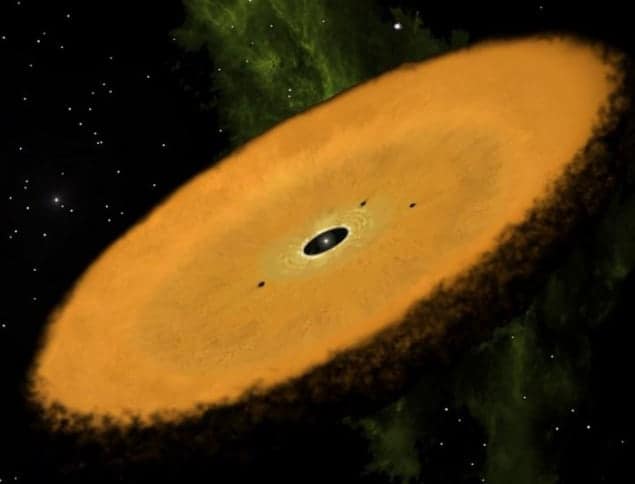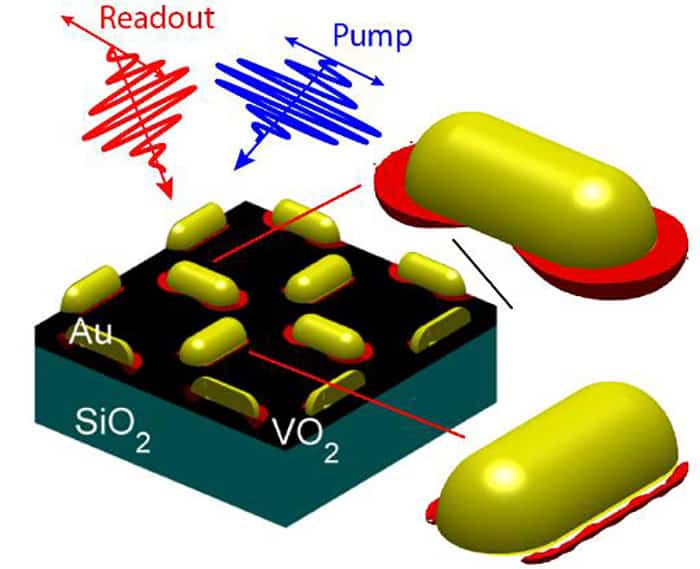Flash Physics is our daily pick of the latest need-to-know developments from the global physics community selected by Physics World‘s team of editors and reporters

Oldest planet-forming disc spotted around red-dwarf star
A star surrounded by the oldest-known circumstellar disc – a primordial ring of gas and dust that usually orbits around a young star, from which planets can form as the material aggregates – has been discovered by an international team of researchers, together with a group of citizen scientists. Led by Steven Silverberg at the University of Oklahoma in the US, the team found that the newly identified red-dwarf star “AWI0005x3s” has a circumstellar disc (a rarity in itself for such a star), which seems to have lasted for an exceptionally long time. “Most discs of this kind fade away in less than 30 million years,” says Silverberg. “This particular red dwarf is a candidate member of the Carina stellar association, which would make it around 45 million years old [like the rest of the stars in that group]. It’s the oldest red-dwarf system with a disc we’ve seen in one of these associations.” Knowing that this star and its disc are so old may help scientists to understand why M-dwarf discs appear to be so rare. The discovery was made possible thanks to members of a NASA-led citizen-scientist programme “Disk Detective” – the project’s users were listed as authors on the research paper, which is published in the Astrophysical Journal Letters.
Greek researcher wins 2016 Farinella Prize for planetary dynamics
The 2016 Paolo Farinella Prize has been awarded to Greek physicist Kleomenis Tsiganis at the Aristotle University of Thessaloniki, for his work on the applications of celestial mechanics to the dynamics of planetary systems, including the development of the “Nice model”, which describes the migration of Jupiter, Saturn, Uranus and Neptune during the early phases of the solar-system’s evolution. It also explains how the interaction of the giant planets with a disc of left-over debris caused a temporary dynamical instability, which led to the outer planets moving to their currently observed orbital configuration. The annual prize, which was established in 2010 to honour the memory of the Italian scientist Paolo Farinella (1953–2000), acknowledges an outstanding researcher not older than 47 years who has achieved important results in one of Farinella’s fields of work. Each year focuses on a different area or research, and the 2016 prize focussed on applications of celestial mechanics in the solar system. “Tsiganis has produced impressive results in modelling the solar system. In particular, he contributed to a deep understanding of the early dynamical phases and architecture of our planetary system,” says prize-committee chair Alessandra Celletti.
Nanoantennas produce fast optical switches

A fast nanoscale optical transistor that uses gold nanoantenna-assisted phase transition has been created by an international team of researchers. The researchers say the study will help develop antenna-assisted switches and optical memory. Small nanostructures that can interact strongly with light are of interest for many novel upcoming devices such as small optical circuits and metasurface flat optics. Nanoantennas are usually designed to function far below the diffraction limit via strong optical resonances. “If we are able to actively tune a nanoantenna using an electrical or optical signal, we could achieve transistor-type switches for light with nanometre-scale footprints for data communication,” says lead author Otto Muskens from the University of Southampton, UK. He adds that such active devices could also be used “to tune the antenna’s light-concentration effects leading to new applications in switchable and tuneable antenna-assisted processes”. The team used the properties of the antenna itself to achieve low-energy optical switching of vanadium dioxide – a phase-change material, which is a functional material and switches from an insulator to a metal above 68 °C. Gold nanoantennas were fabricated on top of a vanadium-dioxide thin film and were used to locally drive its phase transition. The research is published in the journal Light, Science and Applications.
- You can find all our daily Flash Physics posts in the website’s news section, as well as on Twitter and Facebook using #FlashPhysics. Tune in to physicsworld.com later today to read today’s extensive news story on a plan to deal with the rising price of helium.



